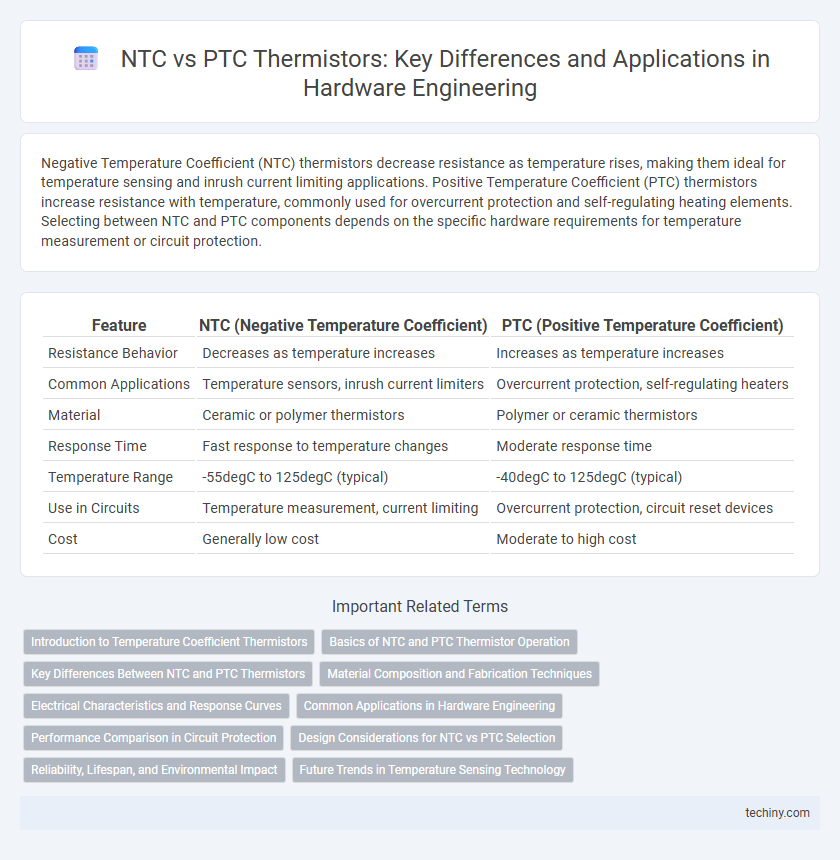Negative Temperature Coefficient (NTC) thermistors decrease resistance as temperature rises, making them ideal for temperature sensing and inrush current limiting applications. Positive Temperature Coefficient (PTC) thermistors increase resistance with temperature, commonly used for overcurrent protection and self-regulating heating elements. Selecting between NTC and PTC components depends on the specific hardware requirements for temperature measurement or circuit protection.
Table of Comparison
| Feature | NTC (Negative Temperature Coefficient) | PTC (Positive Temperature Coefficient) |
|---|---|---|
| Resistance Behavior | Decreases as temperature increases | Increases as temperature increases |
| Common Applications | Temperature sensors, inrush current limiters | Overcurrent protection, self-regulating heaters |
| Material | Ceramic or polymer thermistors | Polymer or ceramic thermistors |
| Response Time | Fast response to temperature changes | Moderate response time |
| Temperature Range | -55degC to 125degC (typical) | -40degC to 125degC (typical) |
| Use in Circuits | Temperature measurement, current limiting | Overcurrent protection, circuit reset devices |
| Cost | Generally low cost | Moderate to high cost |
Introduction to Temperature Coefficient Thermistors
Temperature coefficient thermistors are resistors that exhibit a predictable change in resistance with temperature variations, categorized as Negative Temperature Coefficient (NTC) and Positive Temperature Coefficient (PTC) types. NTC thermistors decrease resistance as temperature rises, making them ideal for temperature sensing and inrush current limiting applications. PTC thermistors increase resistance with temperature, commonly used for overcurrent protection and self-regulating heating elements in hardware engineering designs.
Basics of NTC and PTC Thermistor Operation
NTC thermistors decrease resistance as temperature rises, allowing for precise temperature measurement and control in circuits. PTC thermistors, in contrast, increase resistance with higher temperatures, providing overcurrent protection by limiting current flow during overheating. Both devices leverage temperature-dependent resistance properties but serve distinct roles in hardware engineering applications.
Key Differences Between NTC and PTC Thermistors
NTC thermistors exhibit a decrease in resistance as temperature rises, making them ideal for temperature sensing and inrush current limiting applications. PTC thermistors increase resistance with temperature, commonly used for overcurrent protection and self-regulating heating elements. The key difference lies in their temperature-resistance relationship, influencing their usage in thermal management and circuit protection within hardware engineering.
Material Composition and Fabrication Techniques
Negative Temperature Coefficient (NTC) thermistors primarily use metal oxides such as manganese, cobalt, and nickel, sintered at high temperatures to create a ceramic material with decreasing resistance as temperature rises. Positive Temperature Coefficient (PTC) thermistors often employ polycrystalline materials like barium titanate, fabricated through controlled doping and grain boundary engineering to achieve increased resistance with temperature. Both fabrication techniques emphasize precise thermal treatments that affect grain size and impurities, crucial for defining their respective temperature-resistance behaviors.
Electrical Characteristics and Response Curves
Negative Temperature Coefficient (NTC) thermistors decrease in resistance as temperature rises, exhibiting a nonlinear resistance-temperature curve that allows precise temperature measurements and circuit protection against overheating. Positive Temperature Coefficient (PTC) thermistors increase resistance with rising temperature, often used for overcurrent protection by limiting current flow when a threshold temperature is exceeded, characterized by a sharp resistance rise in response curves. Electrical characteristics of NTC devices include low resistance at high temperatures and rapid response times, while PTC devices maintain high resistance at elevated temperatures, facilitating self-regulating circuit behavior.
Common Applications in Hardware Engineering
Negative Temperature Coefficient (NTC) thermistors are commonly used in temperature sensing, inrush current limiting, and thermal protection circuits due to their resistance decreasing as temperature rises. Positive Temperature Coefficient (PTC) thermistors serve as self-regulating heaters, overcurrent protectors, and resettable fuses because their resistance increases with temperature. Both NTC and PTC components are integral in hardware engineering for ensuring device safety and operational stability under varying thermal conditions.
Performance Comparison in Circuit Protection
Negative Temperature Coefficient (NTC) thermistors decrease resistance as temperature rises, enabling rapid response to inrush currents and efficient heat dissipation in circuit protection applications. Positive Temperature Coefficient (PTC) thermistors increase resistance with temperature, providing self-regulating overcurrent protection by limiting current flow during fault conditions and enhancing circuit safety. Compared to PTCs, NTCs excel in transient current suppression, while PTCs offer superior long-term overcurrent protection and resettable fuse functionality.
Design Considerations for NTC vs PTC Selection
Design considerations for NTC versus PTC resistors hinge on temperature response characteristics and application requirements; NTC thermistors decrease resistance as temperature rises, offering high sensitivity for precise temperature measurement and control in hardware engineering. PTC thermistors increase resistance with temperature, providing overcurrent protection and self-regulating heating elements, ideal for safety-critical designs. Selection depends on balancing sensitivity, response time, operating temperature range, and circuit protection needs to optimize device reliability and performance.
Reliability, Lifespan, and Environmental Impact
Negative Temperature Coefficient (NTC) thermistors generally offer higher reliability and longer lifespan due to their stable resistance decrease as temperature rises, making them ideal for precise temperature sensing in hardware engineering. Positive Temperature Coefficient (PTC) devices provide overcurrent protection with self-regulating heating properties but often have a shorter operational life due to material fatigue under repeated thermal cycling. Environmentally, NTC components tend to have lower energy consumption in steady-state applications, while PTC elements, often based on polymer composites, require careful disposal due to potential environmental hazards from polymer degradation.
Future Trends in Temperature Sensing Technology
Advancements in temperature sensing technology emphasize the integration of Negative Temperature Coefficient (NTC) thermistors for enhanced precision in low-temperature applications and Positive Temperature Coefficient (PTC) devices for reliable overcurrent protection. Future trends highlight the development of hybrid sensors combining NTC and PTC materials with digital interfaces to enable real-time monitoring and adaptive system control. Innovations in nanomaterials and IoT connectivity are driving more compact, energy-efficient temperature sensors with improved response times and durability in complex hardware engineering environments.
Negative Temperature Coefficient (NTC) vs Positive Temperature Coefficient (PTC) Infographic

 techiny.com
techiny.com